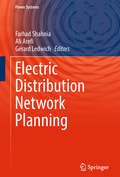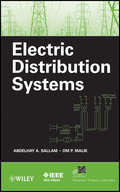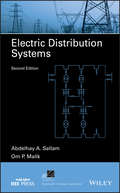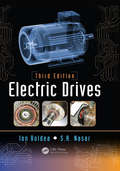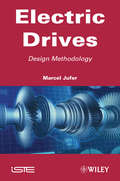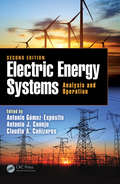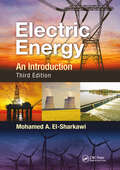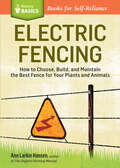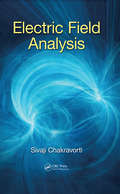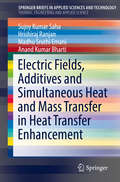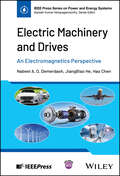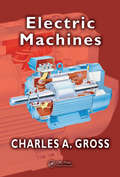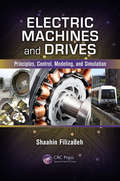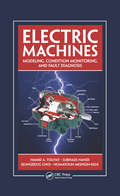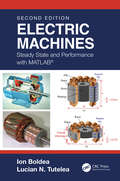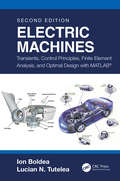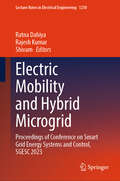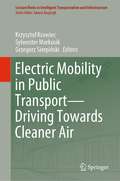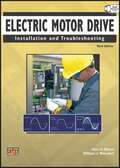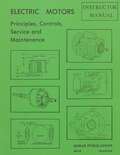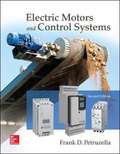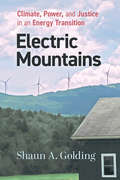- Table View
- List View
Electric Distribution Network Planning (Power Systems)
by Farhad Shahnia Ali Arefi Gerard LedwichThis book highlights the latest research advances in the planning and management of electric distribution networks. It addresses various aspects of distribution network management including planning, operation, customer engagement, and technology accommodation. Given the importance of electric distribution networks in power delivery systems, effectively planning and managing them are vital to satisfying technical, economic, and customer requirements. A new planning and management philosophy, techniques, and methods are essential to handling uncertainties associated with the integration of renewable-based distributed generation, demand forecast, and customer needs. This book covers topics on managing the capacity of distribution networks, while also addressing the future needs of electric systems. The efficient and economical operation of distribution networks is an essential aspect of ensuring the effective use of resources. Accordingly, this book addresses operation and control approaches and techniques suitable for future distribution networks.
Electric Distribution Systems
by Abdelhay A. Sallam Om P. MalikThis book provides a comprehensive treatment of electric distribution systems. Few books cover specific topics in more depth and there is hardly any book that deals with the key topics of interest to distribution system engineers. The book introduces these topics from two points of view: 1) The practical point of view by providing practical examples and the problems which can be solved. 2) The academic point of view where the analysis and various techniques used for distribution system planning are explained. The most outstanding feature of this book is a combination of practical and academic explanation of its contents. Another outstanding feature is a collection of the traditional and current topics of distribution systems condensed into one book. The reader will gain an understanding of distribution systems from both practical and academic aspects, will be able to outline and design a distribution system for specific loads, cities, zones, etc.. Readers will also be able to recognize the problems which may occur during the operation of distribution systems and be able to propose solutions for these problems.
Electric Distribution Systems (IEEE Press Series on Power Engineering #45)
by Abdelhay A. Sallam Om P. MalikA comprehensive review of the theory and practice for designing, operating, and optimizing electric distribution systems, revised and updated Now in its second edition, Electric Distribution Systems has been revised and updated and continues to provide a two-tiered approach for designing, installing, and managing effective and efficient electric distribution systems. With an emphasis on both the practical and theoretical approaches, the text is a guide to the underlying theory and concepts and provides a resource for applying that knowledge to problem solving. The authors—noted experts in the field—explain the analytical tools and techniques essential for designing and operating electric distribution systems. In addition, the authors reinforce the theories and practical information presented with real-world examples as well as hundreds of clear illustrations and photos. This essential resource contains the information needed to design electric distribution systems that meet the requirements of specific loads, cities, and zones. The authors also show how to recognize and quickly respond to problems that may occur during system operations, as well as revealing how to improve the performance of electric distribution systems with effective system automation and monitoring. This updated edition: • Contains new information about recent developments in the field particularly in regard to renewable energy generation • Clarifies the perspective of various aspects relating to protection schemes and accompanying equipment • Includes illustrative descriptions of a variety of distributed energy sources and their integration with distribution systems • Explains the intermittent nature of renewable energy sources, various types of energy storage systems and the role they play to improve power quality, stability, and reliability Written for engineers in electric utilities, regulators, and consultants working with electric distribution systems planning and projects, the second edition of Electric Distribution Systems offers an updated text to both the theoretical underpinnings and practical applications of electrical distribution systems.
Electric Drives
by Syed A. Nasar Ion BoldeaElectric Drives provides a practical understanding of the subtleties involved in the operation of modern electric drives. The Third Edition of this bestselling textbook has been fully updated and greatly expanded to incorporate the latest technologies used to save energy and increase productivity, stability, and reliability. Every phrase, equation, number, and reference in the text has been revisited, with the necessary changes made throughout. In addition, new references to key research and development activities have been included to accurately reflect the current state of the art. Nearly 120 new pages covering recent advances, such as those made in the sensorless control of A.C. motor drives, have been added; as have two new chapters on advanced scalar control and multiphase electric machine drives. All solved numerical examples have been retained, and the 10 MATLAB®–Simulink® programs remain online. Thus, Electric Drives, Third Edition offers an up-to-date synthesis of the basic and advanced control of electric drives, with ample material for a two-semester course at the university level.
Electric Drives
by Ion BoldeaElectric Drives, now in its fourth edition, provides a practical guide in understanding the fundamental principles and recent new knowledge of electric motion (in motoring) and electric energy flow (in generating) digital control via power electronics for energy savings and increased productivity in practically all industries, from intelligent watches and phones to robots, electric transport, industrial processes, and modern distributed electric power systems with ever more renewable energy penetration.Every proposition, number, figure, and reference has been revisited to bring necessary changes, with new references to key recent knowledge trends, to reflect the present state of the art.The book has been restructured, with a few chapters combined and one chapter (on rectifier d.c. brush motor drives) removed, new introductory paragraphs in most chapters (many as inspiring case studies), and brand-new chapters on flux-modulation machine drives (Chapter 8) and predictive control of a.c. drives (Chapter 15), reflecting this updating effort. The large number of new case studies complements the large number of worked numerical examples and the 10 user-friendly MATLABR and SimulinkR programs thatremain available online.Although, inevitably, the math is intensive and intended to be directly usable, the book, mainly intended for senior undergraduate and graduate students and engineers in research and development in industry, is a practical, easy-to-assimilate, and up-to-date synthesis of basic and advanced power electronics (variable speed) electric motor-generator drives needed in all industries in which electric energy flow-wise, mainly digitally intelligent, control is paramount.
Electric Drives: Design Methodology
by Marcel JuferAn electric drive that is designed or adapted to a specific application must take into account all the elements of the chain of constituent elements in its use and deployment. In addition to the motor, the transmission, power electronics, control, sensors, and electrical protection systems must be taken into account. The motor and the transmission can be optimized and designed to obtain the best energy efficiency assessment, in particular for dynamic nodes. An inventory and a characterization of these various components is proposed as part of this book’s examination and explanation of the different technology elements, as well as a dynamic model of the system, with the whole system constituting a methodology for integrated electric drive design.
Electric Energy Systems: Analysis and Operation (Electric Power Engineering Series)
by Antonio Gómez-Expósito, Antonio J. Conejo and Claudio A. CañizaresElectric Energy Systems, Second Edition provides an analysis of electric generation and transmission systems that addresses diverse regulatory issues. It includes fundamental background topics, such as load flow, short circuit analysis, and economic dispatch, as well as advanced topics, such as harmonic load flow, state estimation, voltage and frequency control, electromagnetic transients, etc. The new edition features updated material throughout the text and new sections throughout the chapters. It covers current issues in the industry, including renewable generation with associated control and scheduling problems, HVDC transmission, and use of synchrophasors (PMUs). The text explores more sophisticated protections and the new roles of demand, side management, etc. Written by internationally recognized specialists, the text contains a wide range of worked out examples along with numerous exercises and solutions to enhance understanding of the material. Features Integrates technical and economic analyses of electric energy systems. Covers HVDC transmission. Addresses renewable generation and the associated control and scheduling problems. Analyzes electricity markets, electromagnetic transients, and harmonic load flow. Features new sections and updated material throughout the text. Includes examples and solved problems.
Electric Energy: An Introduction, Third Edition (Power Electronics And Applications Ser.)
by Mohamed A. El-SharkawiThe search for renewable energy and smart grids, the societal impact of blackouts, and the environmental impact of generating electricity, along with the new ABET criteria, continue to drive a renewed interest in electric energy as a core subject. Keeping pace with these changes, Electric Energy: An Introduction, Third Edition restructures the trad
Electric Fencing: How to Choose, Build, and Maintain the Best Fence for Your Plants and Animals. A Storey BASICS® Title (Storey Basics)
by Ann Larkin HansenProtect your livestock and gardens with electric fencing. In this Storey BASICS® guide, Ann Larkin Hansen describes the pros and cons of different varieties of electric fencing so that you can choose the fence that best suits your property and needs. You’ll also learn how electric fencing works and how to put it together yourself. Whether you’re looking for a standard design to reign in your flock or a portable version for rotational grazing, this accessible volume will help you find an efficient, cost-effective solution.
Electric Field Analysis
by Sivaji ChakravortiElectric Field Analysis is both a student-friendly textbook and a valuable tool for engineers and physicists engaged in the design work of high-voltage insulation systems. The text begins by introducing the physical and mathematical fundamentals of electric fields, presenting problems from power and dielectric engineering to show how the theories are put into practice. The book then describes various techniques for electric field analysis and their significance in the validation of numerically computed results, as well as: <P><P>Discusses finite difference, finite element, charge simulation, and surface charge simulation methods for the numerical computation of electric fields Provides case studies for electric field distribution in a cable termination, around a post insulator, in a condenser bushing, and around a gas-insulated substation (GIS) spacer Explores numerical field calculation for electric field optimization, demonstrating contour correction and examining the application of artificial neural networks Explains how high-voltage field optimization studies are carried out to meet the desired engineering needs Electric Field Analysis is accompanied by an easy-to-use yet comprehensive software for electric field computation. The software, along with a wealth of supporting content, is available for download with qualifying course adoption.
Electric Fields in Composite Dielectrics and their Applications
by Tadasu Takuma Boonchai TechaumnatAn accurate quantitative picture of electric field distribution is essential in many electrical and electronic applications. In composite dielectric configurations composed of multiple dielectrics, anomalous or unexpected behavior of electric fields may appear when a solid dielectric is in contact with a conductor or another solid dielectric. The electric field near the contact point may become higher than the original field not only in the surrounding medium but also in the solid dielectric. Theoretically it may become infinitely high, depending on the contact angle. Although these characteristics are very important in a variety of applications, they have been clarified only recently using analytical and numerical calculation methods, and this is the first book to cover these new findings. Electric Fields in Composite Dielectrics and Their Applications describes the fundamental characteristics and practical applications of electric fields in composite dielectrics. The focus is on the field distribution (and the resultant force when appropriate) near points of contact. Applications include insulation design of high-voltage equipment with solid insulating supports, utilization of electrostatic force on dielectric particles in electrophotography and electrorheological fluids, and others. Electric Fields in Composite Dielectrics and Their Applications also explains the calculation methods used to analyze electric fields in composite dielectrics.
Electric Fields, Additives and Simultaneous Heat and Mass Transfer in Heat Transfer Enhancement (SpringerBriefs in Applied Sciences and Technology)
by Sujoy Kumar Saha Hrishiraj Ranjan Madhu Sruthi Emani Anand Kumar BhartiThis Brief deals with electrode design and placement, enhancement of both liquid and gas flow, vapor space condensation, in-tube condensation, falling film evaporation, correlations. It further provides a fundamental understanding of boiling and condensation, pool boiling, critical heat flux, convective vaporization, additives for single-phase liquids like solid particles, gas bubbles, suspensions in dilute polymer and surfactant solutions, solid additives and liquid additives for gases, additives for boiling, condensation and absorption, mass transfer resistance in gas phase (condensation with noncondensible gases, evaporation into air, dehumidifying finned tube heat exchangers, water film enhancement of finned tube exchanger), controlling resistance in liquid phase, and significant resistance in both phases. The volume is ideal for professionals and researchers dealing with thermal management in devices.
Electric Machinery and Drives: An Electromagnetics Perspective (IEEE Press Series on Power and Energy Systems)
by Hao Chen Nabeel A. Demerdash JiangBiao HeComprehensive resource on the fundamentals of electric machinery and variable speed drives, and their many conventional and emerging applications Electric Machinery and Drives: An Electromagnetics Perspective provides advanced concepts of electrical machinery with control/drives and emphasizes the necessity of integration of power electronics and control strategy when studying modern electrical machinery. The text incorporates the fundamentals of electric machinery, variable speed drives, and motor controls, with the scope of including both the introduction of detailed operating principles as well as the electromagnetic design and control details from scratch. The authors start with the introduction of electric circuit notations and elementary concepts of electrical circuits, power electronics, magnetostatics, magnetic circuits, and fundamentals of electromechanical energy conversion. Later, the book elaborates on the operating principles of polyphase induction machines and synchronous machines, as well as the associated scale and vector controls of these machines. To aid in reader comprehension, the text includes a solutions manual and accompanying video animations. Electric Machinery and Drives also contains information on: Real and reactive power in single-phase and balanced three-phase circuits and devices using consumer system concepts and notationsForces and torques in simple magnetically linear and nonlinear, multi-excited electromechanical devices and systemsSimplified T-equivalent circuit model and its use in performance calculations of induction machines and associated torque-slip (speed) characteristicsBrush-commutator and brushless DC machines, and natural ABC frame and Park’s two-reaction DQO frame state-space modeling of synchronous and induction machinesSpecial machines, including single-phase induction machines, switched reluctance machines, and others Electric Machinery and Drives is an ideal learning resource in undergraduate or graduate-level courses for all universities with electrical engineering programs across the world. Additionally, the text may be used as a fundamental reference by researchers and engineers in electrical, mechanical, automotive, aerospace, and automation engineering.
Electric Machines (Electric Power Engineering Series)
by Charles A. GrossThe two major broad applications of electrical energy are information processing and energy processing. Hence, it is no wonder that electric machines have occupied a large and revered space in the field of electrical engineering. Such an important topic requires a careful approach, and Charles A. Gross' Electric Machines offers the most balanced, a
Electric Machines and Drives: Principles, Control, Modeling, and Simulation
by Shaahin FilizadehElectric machines have a ubiquitous presence in our modern daily lives, from the generators that supply electricity to motors of all sizes that power countless applications. Providing a balanced treatment of the subject, Electric Machines and Drives: Principles, Control, Modeling, and Simulation takes a ground-up approach that emphasizes fundamental principles. The author carefully deploys physical insight, mathematical rigor, and computer simulation to clearly and effectively present electric machines and drive systems. Detailing the fundamental principles that govern electric machines and drives systems, this book: Describes the laws of induction and interaction and demonstrates their fundamental roles with numerous examples Explores dc machines and their principles of operation Discusses a simple dynamic model used to develop speed and torque control strategies Presents modeling, steady state based drives, and high-performance drives for induction machines, highlighting the underlying physics of the machine Includes coverage of modeling and high performance control of permanent magnet synchronous machines Highlights the elements of power electronics used in electric drive systems Examines simulation-based optimal design and numerical simulation of dynamical systems Suitable for a one semester class at the senior undergraduate or a graduate level, the text supplies simulation cases that can be used as a base and can be supplemented through simulation assignments and small projects. It includes end-of-chapter problems designed to pick up on the points presented in chapters and develop them further or introduce additional aspects. The book provides an understanding of the fundamental laws of physics upon which electric machines operate, allowing students to master the mathematical skills that their modeling and analysis requires.
Electric Machines: Modeling, Condition Monitoring, and Fault Diagnosis
by Hamid A. Toliyat Subhasis Nandi Seungdeog Choi Homayoun Meshgin-KelkWith countless electric motors being used in daily life, in everything from transportation and medical treatment to military operation and communication, unexpected failures can lead to the loss of valuable human life or a costly standstill in industry. To prevent this, it is important to precisely detect or continuously monitor the working condition of a motor. Electric Machines: Modeling, Condition Monitoring, and Fault Diagnosis reviews diagnosis technologies and provides an application guide for readers who want to research, develop, and implement a more effective fault diagnosis and condition monitoring scheme—thus improving safety and reliability in electric motor operation. It also supplies a solid foundation in the fundamentals of fault cause and effect. Combines Theoretical Analysis and Practical Application Written by experts in electrical engineering, the book approaches the fault diagnosis of electrical motors through the process of theoretical analysis and practical application. It begins by explaining how to analyze the fundamentals of machine failure using the winding functions method, the magnetic equivalent circuit method, and finite element analysis. It then examines how to implement fault diagnosis using techniques such as the motor current signature analysis (MCSA) method, frequency domain method, model-based techniques, and a pattern recognition scheme. Emphasizing the MCSA implementation method, the authors discuss robust signal processing techniques and the implementation of reference-frame-theory-based fault diagnosis for hybrid vehicles. Fault Modeling, Diagnosis, and Implementation in One Volume Based on years of research and development at the Electrical Machines & Power Electronics (EMPE) Laboratory at Texas A&M University, this book describes practical analysis and implementation strategies that readers can use in their work. It brings together, in one volume, the fundamentals of motor fault conditions, advanced fault modeling theory, fault diagnosis techniques, and low-cost DSP-based fault diagnosis implementation strategies.
Electric Machines: Steady State and Performance with MATLAB®
by Ion Boldea Lucian N. TuteleaWith its comprehensive coverage of the state of the art, this Second Edition introduces basic types of transformers and electric machines. Classifications and characterization—modeling and performance—of power electric transformers (single and multiphase), motors and generators, commercial machines (dc brush, induction dc excited synchronous, PM synchronous, reluctance synchronous) and some new ones (multiphase ac machines, switched reluctance machines) with great potential for industry with rotary or linear motion are all treated in the book. The book covers, in detail, circuit modeling characteristics and performance characteristics under steady state, testing techniques and preliminary electromagnetic-thermic dimensioning with lots of solved numerical examples and special cases to illustrate new electric machines with strong industrialization potential. All formulae used to characterize parameters and performance may be safely used in industry for preliminary designs and have been applied in the book through numerical solved examples of industrial interest. Numerous computer simulation programs in MATLAB® and Simulink® that illustrate performance characteristics present in the chapters are included and many be used as homework to facilitate a deeper understanding of fundamental issues. This book is intended for a first-semester course covering electric transformers, rotary and linear machines, steady-state modeling and performance computation, preliminary dimensioning, and testing standardized and innovative techniques. The textbook may be used by R&D engineers in industry as all machine parameters and characteristics are calculated by ready-to-use industrial design mathematical expressions.
Electric Machines: Transients, Control Principles, Finite Element Analysis, and Optimal Design with MATLAB®
by Ion Boldea Lucian N. TuteleaThis Second Edition extensively covers advanced issues/subjects in electric machines, starting from principles, to applications and case studies with ample graphical (numerical) results. This textbook is intended for second (and third) semester courses covering topics such as modeling of transients, control principles, electromagnetic and thermal finite element analysis, and optimal design (dimensioning). Notable recent knowledge with strong industrialization potential has been added to this edition, such as: Orthogonal models of multiphase a.c. machines Thermal Finite Element Analysis of (FEA) electric machines FEA–based–only optimal design of a PM motor case study Line start synchronizing premium efficiency PM induction machines Induction machines (three and single phase), synchronous machines with DC excitation, with PM-excitation, and with magnetically salient rotor and a linear Pm oscillatory motor are all investigated in terms of transients, electromagnetic FEM analysis and control principles. Case studies, numerical examples, and lots of discussion of FEM results for PMSM and IM are included throughout the book. The optimal design is treated in detail using Hooke–Jeeves and GA algorithms with case comparison studies in dedicated chapters for IM and PMSM. Numerous computer simulation programs in MATLAB® and Simulink® are available online that illustrate performance characteristics present in the chapters, and the FEM and optimal design case studies (and codes) may be used as homework to facilitate a deeper understanding of fundamental issues.
Electric Mobility and Hybrid Microgrid: Proceedings of Conference on Smart Grid Energy Systems and Control, SGESC 2023 (Lecture Notes in Electrical Engineering #1230)
by Rajesh Kumar Ratna Dahiya ShivamThe book contains selected proceedings from the International Conference on Smart Grid Energy Systems and Control (SGESC 2023). It is divided into 2 volumes and focuses on Electric Mobility and Hybrid Microgrid. The topics covered include power electronics for hybrid and electric vehicles, wireless power transfer, renewable power generation, energy storage, and challenges in grid integration of microgrids. This book is a valuable resource for academic researchers and industry practitioners.
Electric Mobility in Public Transport—Driving Towards Cleaner Air (Lecture Notes in Intelligent Transportation and Infrastructure)
by Grzegorz Sierpiński Krzysztof Krawiec Sylwester MarkusikThis book addresses various aspects of electric mobility deployment in public transport. These include transport policy-related issues as well as technical, organizational and technical dimensions of the fleet conversion process (from conventional one towards the increased share of electric vehicles in public transport). In the book, one may find, e.g. the determinants for the successful functioning of electrified transport systems (including charging facilities), models and methods for battery electric bus energy consumption, the analysis regarding the charging strategies (including power-grid) as well as electric vehicle battery issues. As the process of fleet conversion is multi-faceted, the book also contains the issues related to cybersecurity in public transport, autonomous vehicles and hyperloop. The book is dedicated to transport professionals, consulting companies and researchers in the field of electromobility and modern transport systems.
Electric Motor Drive Installation and Troubleshooting
by Glen A. Mazur William J. WeindorfElectric Motor Drive Installation and Troubleshooting is a text/workbook designed for technicians responsible for installing, programming, troubleshooting, and retrofitting electric motor drives. This industry-leading resource covers electric motor principles, power requirements, control methods, and the safe operation, installation, startup, and troubleshooting of electric motor drives. This edition provides comprehensive coverage of electric motor drive retrofit procedures and proven, real-world application scenarios. NFPA 70E® safety information is also included. Activities provide real-world electric motor drive applications.
Electric Motors Principles, Controls, Service, & Maintenance Instructor's Guide
by Forrest W. BearThis manual has been prepared for teachers and students in Vocational Agriculture and Industrial Education, at the secondary and post secondary levels. An educator can utilize this text for study of the fundamentals of electricity, generation of electricity, motor principles, overload protection devices, switches and sensing divices for controlling motors, wiring of circuits, testing of motors and essential service and maintenance. There are also classroom and laboratory exercises which reinforce the technical subject matter in each unit. ,
Electric Motors and Control Systems
by Frank D. PetruzellaThis book has been written for a course of study that will introduce the reader to a broad range of motor types and control systems. It provides an overview of electric motor operation, selection, installation, control and maintenance. Every effort has been made in this second edition to present the most up-to-date information which reflects the current needs of the industry. The broad based approach taken makes this text viable for a variety of motors and control systems courses. Content is suitable for colleges, technical institutions, vocational/technical schools as well as apprenticeship and journeymen training. Electrical apprentices and journeymen will find this book to be invaluable due to Electrical Code references applicable to the installation of new control systems and motors, as well as information on maintenance and troubleshooting techniques. Personnel involved in the motor maintenance and repair will find this book to be a useful reference text. The text is comprehensive! It includes coverage of how motors operate in conjunction with their associated control circuitry. Both older and newer motor technologies are examined. Topics covered range from motor types and controls to installing and maintaining conventional controllers, electronic motor drives and programmable logic controllers. Also Available! Activities Manual for Electric Motors and Control Systems, as well as, McGraw-Hill Education's Connect! Connect is the only integrated learning system that empowers students by continuously adapting to deliver precisely what they need, when they need it, and how they need it, so that your class time is more engaging and effective. SAVE WHEN YOU BUY A PACKAGE!Electric Motors & Control Systems 2/e Textbook + Activities Manual ISBN: 1259332837 WILL BE AVAILABLE FEBRUARY 2015
Electric Mountains: Climate, Power, and Justice in an Energy Transition (Nature, Society, and Culture)
by Shaun A. GoldingClimate change has shifted from future menace to current event. As eco-conscious electricity consumers, we want to do our part in weening from fossil fuels, but what are we actually a part of? Committed environmentalists in one of North America’s most progressive regions desperately wanted energy policies that address the climate crisis. For many of them, wind turbines on Northern New England’s iconic ridgelines symbolize the energy transition that they have long hoped to see. For others, however, ridgeline wind takes on a very different meaning. When weighing its costs and benefits locally and globally, some wind opponents now see the graceful structures as symbols of corrupted energy politics. This book derives from several years of research to make sense of how wind turbines have so starkly split a community of environmentalists, as well as several communities. In doing so, it casts a critical light on the roadmap for energy transition that Northern New England’s ridgeline wind projects demarcate. It outlines how ridgeline wind conforms to antiquated social structures propping up corporate energy interests, to the detriment of the swift de-carbonizing and equitable transformation that climate predictions warrant. It suggests, therefore, that the energy transition of which most of us are a part, is probably not the transition we would have designed ourselves, if we had been asked.
Electric Noir: Three Thrillers: The Night Market, The Poison Artist, The Dark Room
by Jonathan MooreThe &“suspense that never stops&” in this thriller trilogy set in San Francisco by the Edgar Award and Hammett Prize–nominated author (James Patterson).The Poison Artist After a fleeting encounter with a seductive woman, toxicologist Caleb Maddox becomes obsessed with finding her again. Meanwhile, he begins helping with a serial-murder investigation. Soon the search for the killer entwines with Caleb&’s hunt for the woman in &“a wicked mix of Poe, The Silence of the Lambs, and Vertigo&” (William Landay).The Dark Room Homicide inspector Gavin Cain is called in for a highly sensitive case: the mayor is being blackmailed. A series of photographs show a beautiful woman shackled to a bed. And worse revelations are to come if the mayor doesn&’t take his own life first. This &“electrifying noir thriller&” tracks Cain as he enters a web of deceit and destruction (Booklist, starred review).The Night Market In this &“sharp and scary near-future thriller,&” Inspector Ross Carver is at a crime scene where a dead man is covered in an unknown substance eating through his skin. Suddenly, he&’s hauled into a trailer and shocked unconscious. When he wakes up days later, he&’s in his own bed, lying next to his neighbor Mia—a woman he barely knows. And she knows a lot more than she&’s letting on (Publishers Weekly, starred review).
